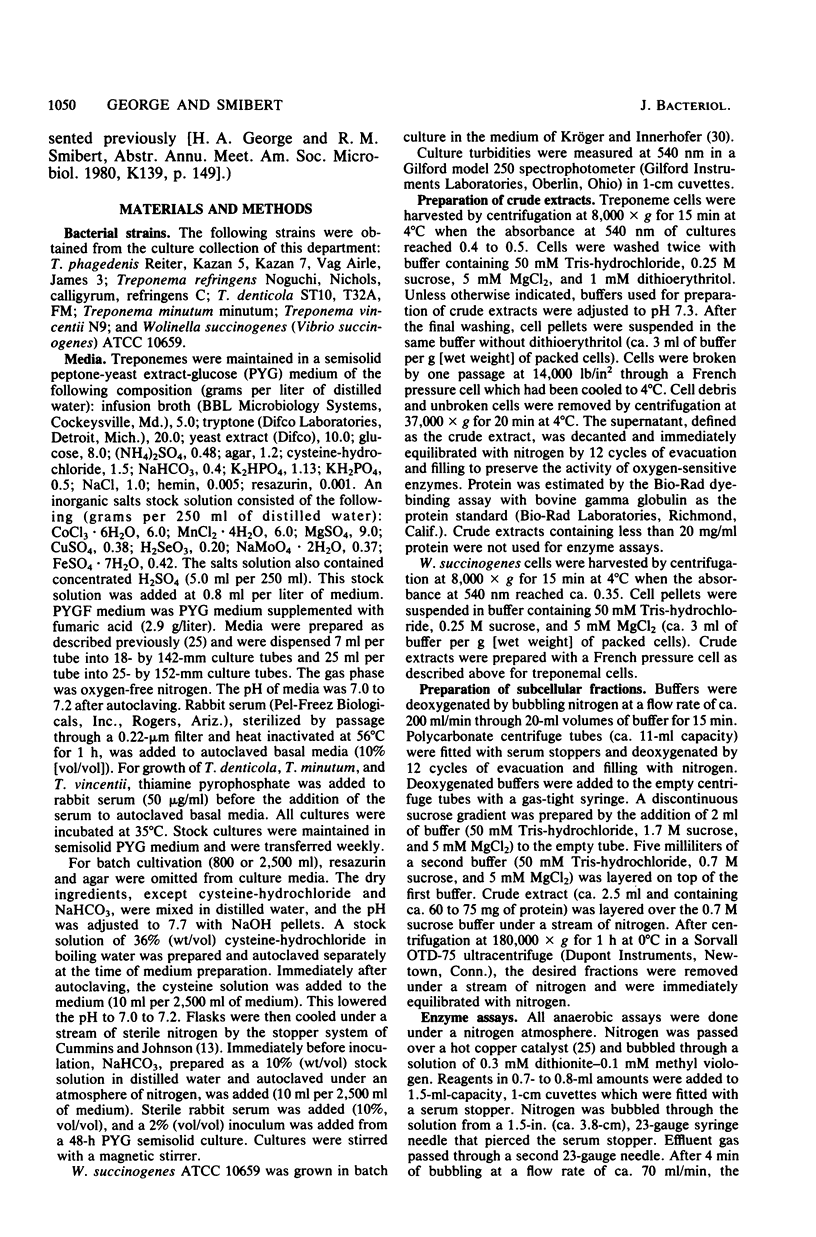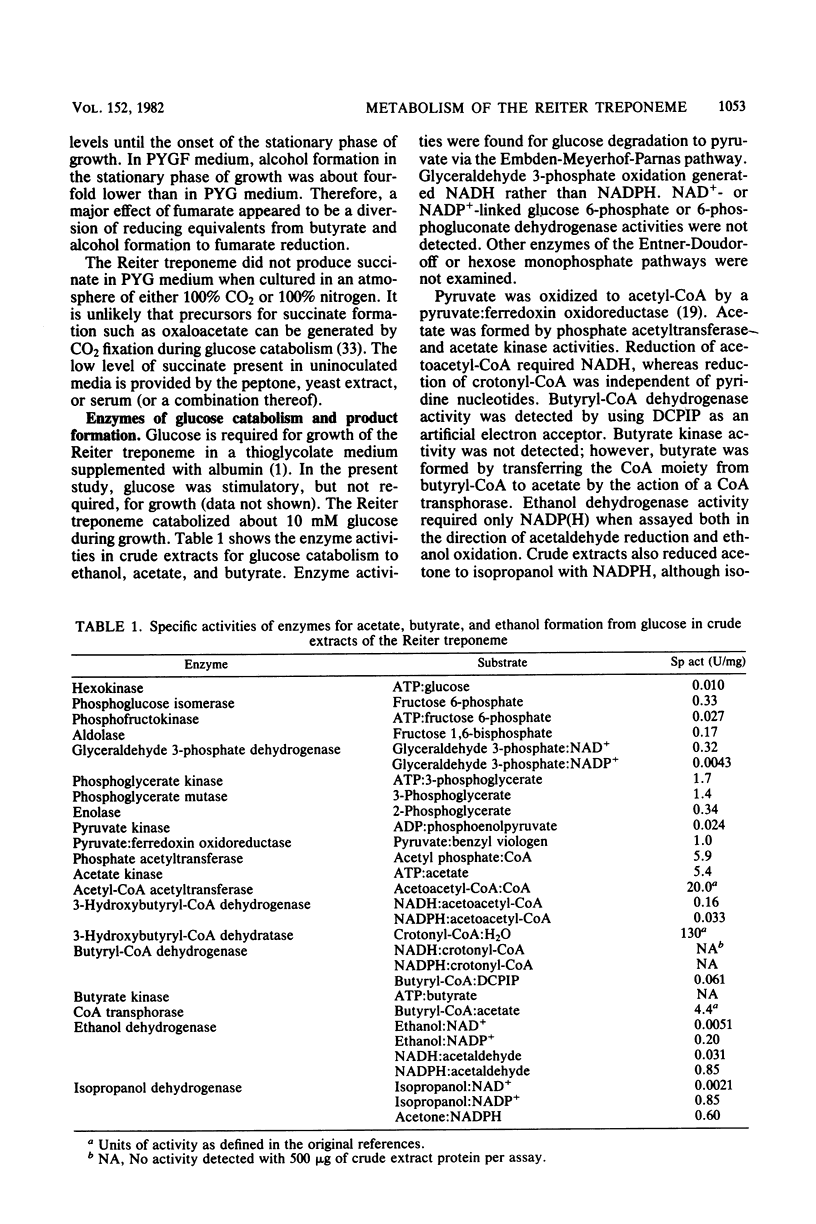Abstract
The catabolic pathways for butyrate, acetate, succinate, and ethanol formation by the Reiter strain of Treponema phagedenis were investigated. Enzyme activities were demonstrated for glucose catabolism to pyruvate by the Embden-Meyerhof-Parnas pathway. Butyrate formation from acetyl-coenzyme A (acetyl-CoA) does not generate ATP by substrate level phosphorylation and involves NAD+-dependent 3-hydroxybutyryl-CoA dehydrogenase and NAD(P)+-independent butyryl-CoA dehydrogenase activities. Butyrate is formed from butyryl-CoA in a CoA transphorase reaction. Phosphate acetyltransferase and acetate kinase activities convert acetyl-CoA to acetate. An NADP+-dependent alcohol dehydrogenase participates in ethanol formation; however, the manner in which acetyl-CoA is reduced to acetaldehyde is unclear. A membrane-associated fumarate reductase was found which utilized reduced ferredoxin or flavin nucleotides as physiological electron donors. Additional electron carriers may also be involved in electron transfer for fumarate reduction. Strains of Treponema denticola, T. vincentii, and T. minutum utilized fumarate without succinate formation, whereas strains of T. phagedenis and T. refringens formed succinate from exogenously supplied fumarate.
Full text
PDF










Selected References
These references are in PubMed. This may not be the complete list of references from this article.
- Allen S. L., Johnson R. C., Peterson D. Metabolism of Common Substrates by the Reiter Strain of Treponema pallidum. Infect Immun. 1971 Jun;3(6):727–734. doi: 10.1128/iai.3.6.727-734.1971. [DOI] [PMC free article] [PubMed] [Google Scholar]
- BARBAN S. Studies on the metabolism of the Treponemata. I. Amino acid metabolism. J Bacteriol. 1954 Oct;68(4):493–497. doi: 10.1128/jb.68.4.493-497.1954. [DOI] [PMC free article] [PubMed] [Google Scholar]
- BARBAN S. Studies on the metabolism of the treponemata. II. Transamination in the Reiter treponeme. J Bacteriol. 1956 Mar;71(3):274–277. doi: 10.1128/jb.71.3.274-277.1956. [DOI] [PMC free article] [PubMed] [Google Scholar]
- Ben-Bassat A., Lamed R., Zeikus J. G. Ethanol production by thermophilic bacteria: metabolic control of end product formation in Thermoanaerobium brockii. J Bacteriol. 1981 Apr;146(1):192–199. doi: 10.1128/jb.146.1.192-199.1981. [DOI] [PMC free article] [PubMed] [Google Scholar]
- Brockman H. L., Wood W. A. Electron-transferring flavoprotein of Peptostreptococcus elsdenii that functions in the reduction of acrylyl-coenzyme A. J Bacteriol. 1975 Dec;124(3):1447–1453. doi: 10.1128/jb.124.3.1447-1453.1975. [DOI] [PMC free article] [PubMed] [Google Scholar]
- Chen J. S., Blanchard D. K. A simple hydrogenase-linked assay for ferredoxin and flavodoxin. Anal Biochem. 1979 Feb;93(1):216–222. [PubMed] [Google Scholar]
- Chiba S., Ishimoto M. Ferredoxin-linked nitrate reductase from Clostridium perfringens. J Biochem. 1973 Jun;73(6):1315–1318. doi: 10.1093/oxfordjournals.jbchem.a130208. [DOI] [PubMed] [Google Scholar]
- Collins M. D., Pirouz T., Goodfellow M., Minnikin D. E. Distribution of menaquinones in actinomycetes and corynebacteria. J Gen Microbiol. 1977 Jun;100(2):221–230. doi: 10.1099/00221287-100-2-221. [DOI] [PubMed] [Google Scholar]
- Cwyk W. M., Canale-Parola E. Treponema succinifaciens sp. nov., an anaerobic spirochete from the swine intestine. Arch Microbiol. 1979 Sep;122(3):231–239. doi: 10.1007/BF00411285. [DOI] [PubMed] [Google Scholar]
- DEIBEL R. H., KVETKAS M. J. FUMARATE REDUCTION AND ITS ROLE IN THE DIVERSION OF GLUCOSE FERMENTATION BY STREPTOCOCCUS FAECALIS. J Bacteriol. 1964 Oct;88:858–864. doi: 10.1128/jb.88.4.858-864.1964. [DOI] [PMC free article] [PubMed] [Google Scholar]
- Dickie P., Weiner J. H. Purification and characterization of membrane-bound fumarate reductase from anaerobically grown Escherichia coli. Can J Biochem. 1979 Jun;57(6):813–821. doi: 10.1139/o79-101. [DOI] [PubMed] [Google Scholar]
- Eagle H., Steinman H. G. The Nutritional Requirements of Treponemata: I. Arginine, Acetic Acid, Sulfur-containing Compounds, and Serum Albumin as Essential Growth-promoting Factors for the Reiter Treponeme. J Bacteriol. 1948 Aug;56(2):163–176. [PMC free article] [PubMed] [Google Scholar]
- Engel P. C., Massey V. The purification and properties of butyryl-coenzyme A dehydrogenase from Peptostreptococcus elsdenii. Biochem J. 1971 Dec;125(3):879–887. doi: 10.1042/bj1250879. [DOI] [PMC free article] [PubMed] [Google Scholar]
- George H. A., Smibert R. M. Pyruvate oxidation by the Reiter strain of Treponema phagedenis. J Bacteriol. 1982 Dec;152(3):1060–1065. doi: 10.1128/jb.152.3.1060-1065.1982. [DOI] [PMC free article] [PubMed] [Google Scholar]
- Hasan S. M., Hall J. B. The physiological function of nitrate reduction in Clostridium perfringens. J Gen Microbiol. 1975 Mar;87(1):120–128. doi: 10.1099/00221287-87-1-120. [DOI] [PubMed] [Google Scholar]
- Hatchikian E. C., Le Gall J. Etude du métabolisme des acides dicarboxyliques et du pyruvate chez les bactéries sulfato-réductrices. II. Transport des électrons; accepteurs finaux. Ann Inst Pasteur (Paris) 1970 Mar;118(3):288–301. [PubMed] [Google Scholar]
- Henneberry R. C., Cox C. D. Beta-oxidation of fatty acids by Leptospira. Can J Microbiol. 1970 Jan;16(1):41–45. doi: 10.1139/m70-007. [DOI] [PubMed] [Google Scholar]
- Hespell R. B., Canale-Parola E. Amino acid and glucose fermentation by Treponema denticola. Arch Mikrobiol. 1971;78(3):234–251. doi: 10.1007/BF00424897. [DOI] [PubMed] [Google Scholar]
- Hillier A. J., Jericho R. E., Green S. M., Jago G. R. Properties and function of fumarate reductase (NADH) in Streptococcus lactis. Aust J Biol Sci. 1979 Dec;32(6):625–635. doi: 10.1071/bi9790625. [DOI] [PubMed] [Google Scholar]
- Ishimoto M., Umeyama M., Chiba S. Alteration of fermentation products from butyrate to acetate by nitrate reduction in Clostridium perfringens. Z Allg Mikrobiol. 1974;14(2):115–121. doi: 10.1002/jobm.3630140206. [DOI] [PubMed] [Google Scholar]
- Jungermann K., Thauer R. K., Leimenstoll G., Decker K. Function of reduced pyridine nucleotide-ferredoxin oxidoreductases in saccharolytic Clostridia. Biochim Biophys Acta. 1973 May 30;305(2):268–280. doi: 10.1016/0005-2728(73)90175-8. [DOI] [PubMed] [Google Scholar]
- Kawata T. [Electron transport system in the cell fraction of the Reiter treponeme, with special reference to the presence of cytochromes]. Nihon Saikingaku Zasshi. 1967 Oct;22(10):590–594. doi: 10.3412/jsb.22.590. [DOI] [PubMed] [Google Scholar]
- Kröger A. Fumarate as terminal acceptor of phosphorylative electron transport. Biochim Biophys Acta. 1978 Oct 23;505(2):129–145. doi: 10.1016/0304-4173(78)90010-1. [DOI] [PubMed] [Google Scholar]
- Lamed R., Zeikus J. G. Glucose fermentation pathway of Thermoanaerobium brockii. J Bacteriol. 1980 Mar;141(3):1251–1257. doi: 10.1128/jb.141.3.1251-1257.1980. [DOI] [PMC free article] [PubMed] [Google Scholar]
- Macy J., Probst I., Gottschalk G. Evidence for cytochrome involvement in fumarate reduction and adenosine 5'-triphosphate synthesis by Bacteroides fragilis grown in the presence of hemin. J Bacteriol. 1975 Aug;123(2):436–442. doi: 10.1128/jb.123.2.436-442.1975. [DOI] [PMC free article] [PubMed] [Google Scholar]
- Miller T. L. The pathway of formation of acetate and succinate from pyruvate by Bacteroides succinogenes. Arch Microbiol. 1978 May 30;117(2):145–152. doi: 10.1007/BF00402302. [DOI] [PubMed] [Google Scholar]
- STEINMAN H. G., EAGLE H., OYAMA V. I. Nutritional requirements of Treponemata. IV. The total nitrogen requirements of the Reiter Treponeme. J Biol Chem. 1953 Feb;200(2):775–785. [PubMed] [Google Scholar]
- STEINMAN H. G., EAGLE H., OYAMA V. I. The nutritional requirements of Treponemata. III. A defined medium for cultivation of the Reiter treponeme. J Bacteriol. 1952 Aug;64(2):265–269. doi: 10.1128/jb.64.2.265-269.1952. [DOI] [PMC free article] [PubMed] [Google Scholar]
- Salanitro J. P., Muirhead P. A. Quantitative method for the gas chromatographic analysis of short-chain monocarboxylic and dicarboxylic acids in fermentation media. Appl Microbiol. 1975 Mar;29(3):374–381. doi: 10.1128/am.29.3.374-381.1975. [DOI] [PMC free article] [PubMed] [Google Scholar]
- Stanton T. B., Canale-Parola E. Treponema bryantii sp. nov., a rumen spirochete that interacts with cellulolytic bacteria. Arch Microbiol. 1980 Sep;127(2):145–156. doi: 10.1007/BF00428018. [DOI] [PubMed] [Google Scholar]
- TAUBER H., CANNEFAX G. R., HANSON A. W., RUSSELL H. Enzymes of treponemes. A comparative study. Exp Med Surg. 1962;20:324–328. [PubMed] [Google Scholar]
- Thauer R. K., Jungermann K., Decker K. Energy conservation in chemotrophic anaerobic bacteria. Bacteriol Rev. 1977 Mar;41(1):100–180. doi: 10.1128/br.41.1.100-180.1977. [DOI] [PMC free article] [PubMed] [Google Scholar]
- de Vries W., Rietveld-Struijk R. M., Stouthamer A. H. ATP formation associated with fumarate and nitrate reduction in growing cultures of Veillonella alcalescens. Antonie Van Leeuwenhoek. 1977;43(2):153–167. doi: 10.1007/BF00395670. [DOI] [PubMed] [Google Scholar]


